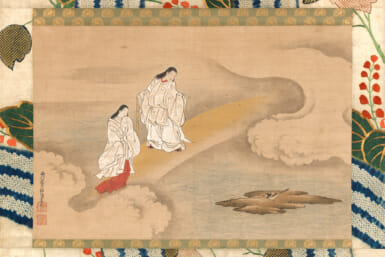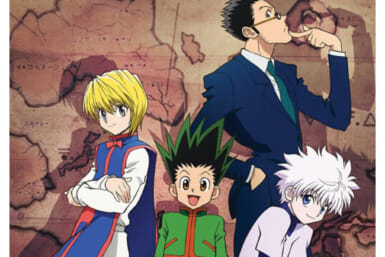Poet-essayist-musician Jack Stamm takes us into the 5-7-5 world of haiku
One of the most touchingly beautiful haiku I know occurs in the song “Mountains of the Moon” by the Grateful Dead. They sing, “…hey, the city in the rain” — and then, the haiku:
“Hey, hey, hey / the wild wheat / waving in the wind.”
Of the hundred or so haiku that I have written in Japanese, maybe fifteen are passable, a few are good. One or two are very fine, indeed, thank you. Last year I submitted an entry to The Mainichi Daily News‘ winter English-language haiku contest. The contest rules asked for the contestant’s name and address, occupation (?) and age (!!?). I wrote:
Asked my age again / I feel my bones, my blood, / the cold, outside.
I made runner-up. My friend Shigeru Ekuni — painter, essayist and published haiku poet — subsequently translated this. Everyone admits that his Japanese version is much better than my English original. Win a few, lose a few.
When you recall a poem, don’t you find that the recollection usually commences with a two or three lines? Standing alone, these lines lose nothing; the poem surrounds them and shines by their light. They seem to be the essence of the poem.
The singularity of a haiku is that it is all essence. What the poet conceives must become flesh on the bare bones of three lines.
Haiku have attracted non-Japanese poets since the early part of this century. Auden wrote haiku, so did Pound. And if Wallace Steven’s “Thirteen Ways of Looking at a Blackbird” doesn’t remind you of haiku, I will eat his collected works.
Haiku are poetic microchips; the embodiment of the idea that the less said the better.
Check this out:
Rain is coming down / like a soft gray stage curtain, / as I long for you
In a haiku‘s narrow confines, adjectives are poised to drop heavily on frail nouns; prepositions behave neurotically. With three lines or less to stretch out in, handy little “like” and “as” become great shambling oafs and smash the crockery.
Now make it, say —
through the north window / curtained by an on-off rain / a snapshot and I
Any magician will tell you that loneliness comes from the north. Windows make good frames. Literal-minded readers are no longer forced to wonder where on earth rain comes from any direction but up. The rain is doing double duty as a curtain; and the curtain is working as a verb. “Through” gives the reader the choice of looking in or out. And it’s got to be autumn. Experienced yearners know that autumn is the longing-est time of year. And so you have changed a sugary little gush into a haiku about love.
Japanese with its subject-less sentence allows the writer to employ subtle ambiguities. In Japanese adjectives can behave like verbs. There are handy little auxiliary words which appear to have no other job than to express delicate shades of emotion. Kazue Mizumura, an artist and haiku poet, calls them “soul punctuation.” English, with none of the above, can produce its own gems. In an English haiku you can dance chorus lines of action words:
Retired at last / an old umbrella bounces, / skips, twirls with the wind.
The nearest I got to this in Japanese was,
suterareshi / komorigasa ya / aki no kaze
thrown away / a black umbrella / the autumn wind
Haiku is a Japanese invention. The classic, Japanese-form demands three lines of five, seven and five syllables respectively. The five-seven-five beat is fine in the Japanese language. (Japanese haiku poets slip in a beat or drop one if they think it makes the poem better.)
English has not quite agreed about the rules. It’s all right to write 17 syllables and break them up any way you want to. Or forget the 17 syllables, and suit yourself with the length of the lines. J.W. Hackett’s free-form
Searching on the wind / the hawk’s cry / is the shape of its beak.
was a prize-winner in the 1963 American Haiku contest.
moon / in the tide / with Mother’s ashes
says volumes of sorrow and acceptance in nine syllables, seven words. This haiku by Sylvia Forges-Ryan was voted best haiku in the free-style submissions for the year by The Mainichi Daily News. Here’s another shorty:
Mountains / trying on / new clouds
By this time it has probably hit you that all haiku have something to say, directly or by implication, about a season of the year. For the traditional Japanese form, this is a built-in requirement: Japan has four distinct seasons. Don’t let this faze you. Excellent haiku have come from Arabia and Nigeria. Since nature, and by extension, man in nature, are what haiku are all about, a season is bound to slip in there, sometimes behind the poet’s back.
Oh god, my ankles; / god, my shins! oh god / your shrine has a long stairway
Haiku can be amusing. That one had to be winter, the beginning of the year, when all Japan visits shrines. It also comes close to the satirical haiku-like form called, senryu. Senryu can be sad, humorous, satirical, risque, whatever. They often make a social comment and need not contain a seasonal reference. Here are two senryu, translated from Japanese
Karaoke! / Hiding the yawns / . . .applauding.
Wedding banquet. . . / False teeth giving trouble / during the speech.
The varieties of American society, landscapes and climates are powerful raw material for haiku —
bus-stop / flatland everywhere / next stop, nowhere
Spanish moss, and then / tree frogs singing to the night / and then, magnolias!
Let me set up another haiku paper-tiger to shoot down.
against red twilight / an old man with his grandson — / autumn is here.
What’s wrong? I got the 5, 7, 5 right. I’ve given you grandpa and grandson, a nice twilight, painted it red, even, and — to make sure you don’t miss the point — advised you that it’s autumn. Now, make it —
stretched by the twilight / a baby’s shadow next to / an old man’s shadow
Look! Against the sky, those shadows are loooooong. The old gent and the child now belong to both of us. Rather than a grandsire, you might want to imagine a proud, elderly father, or a nice old greezer who just happened to be there. Without mentioning autumn, I’ve suggested a time of year when life dies to make new life. The kid will be taller, come spring, and the old man may not be around anymore.
Here is one way to think about haiku:
The heart of a haiku is the silence around it.









